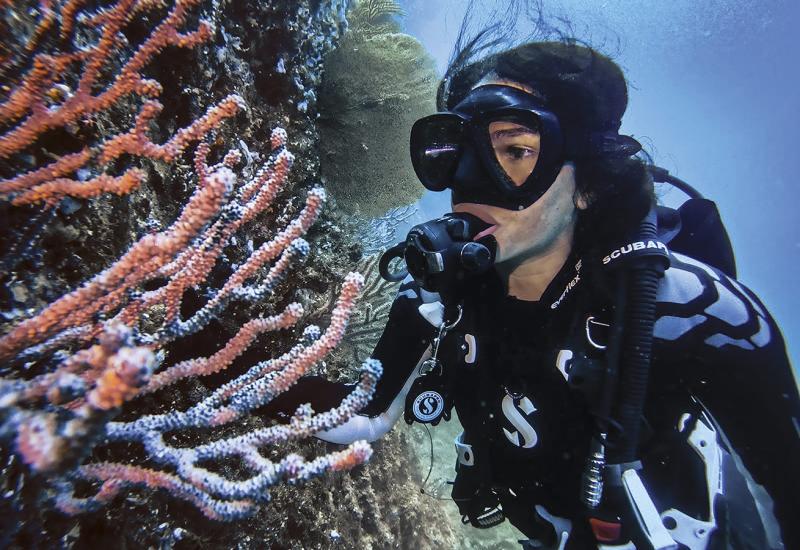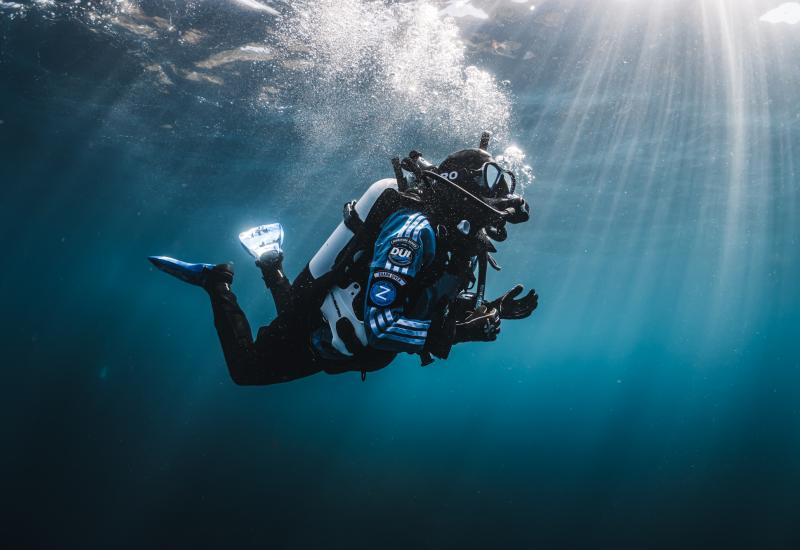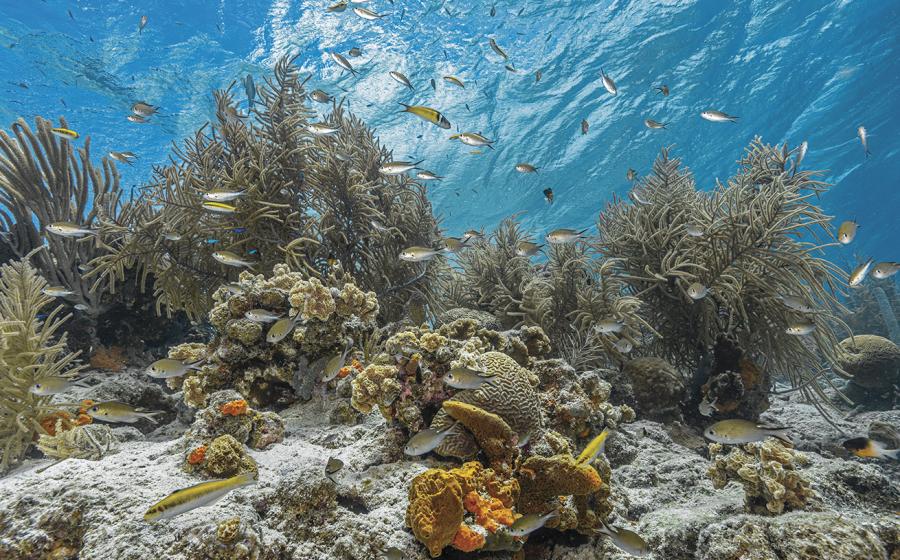10 Frequently Asked Questions by Scuba Divers
We've rounded up 10 frequently asked questions by scuba divers — from surfacing with blood in your mask to exercising after a dive. Here are the answers.

ShutterstockDivers are taught to set up their weight belts with a right-hand release. But is this rule OK to break (Question #7)?
FAQ #1
Is it safe to exercise after diving?
Studies have shown as much as a 34 percent increase in the incidence of decompression sickness in divers who exercised immediately after diving. Does that mean that other than the workout you get beneath the waves, you have to be a couch potato during your next dive vacation? Probably not, as long as you take it easy and don't push yourself or your dive computer or tables. If you do exercise, make intelligent decisions about how soon after diving you'll exercise, how strenuously you'll exercise and for how long.
FAQ #2
A buddy of mine told me I waste precious tank air every time I use my power inflator. Can I really conserve air by inflating my BC orally?
The better question may be: Can you save any air by orally inflating your BC?
The answer is a quiet "yes" with an emphatic "but" — and only when you're above water.
It seems to make sense: you use exhaled air to inflate the BC and therefore save cylinder air. If you're out of the water or on the surface, oral inflation will save cylinder air, but only a very small amount. And under water, oral inflation will actually increase your air consumption.
To inflate your BC orally under water, you have to change your breathing pattern and interrupt your life support, while keeping enough air in your lungs to clear the regulator for your next breath. In many instances, you'll have to repeat the procedure several times: venting your lungs, pausing to check that you've added enough air to the BC, and possibly moving through the water or performing other tasks at the same time. In the process, you'll end up expending more air-air that comes from your tank-than you saved.
Even on the surface, it makes more sense to keep your regulator in your mouth. Only inflate your BC at the surface orally if you are completely comfortable removing your regulator, and even then don't expect any noticeable air savings. In short, except for once in awhile for practice use your power inflator, and save your breath.
FAQ #3
Why do I sink when I stop swimming along the reef?
When swimming underwater our bodies create lift, almost like an airplane's wing. That's the main reason we tend to sink when we pause — we need less buoyancy when we're swimming. If you are neutral while swimming, usually taking a deeper breath or slightly tweaking the power inflator when stationary will be enough to compensate.
FAQ #4
I can't find the boat. Should I surface?
The best way to handle this situation depends on a number of factors: How much air do you and your buddy have left? How strong is the current on the surface and at depth? Can you make a safety stop before surfacing? Do you have a compass so that you can take a reading to the boat on the surface and then swim back at depth?
Remember that if it's not an emergency and you have enough air to do so, it's usually prudent to make a safety stop before surfacing. If you're going to surface to look for the boat, make your safety stop first. If you swim at 10 to 30 feet while searching for the boat for three minutes or more, then you have performed a safety stop.
There are a couple of good reasons for returning to depth for the swim back to the boat. For one, swimming on the surface is less efficient than swimming underwater — scuba fins are designed to function best when fully submerged. Also, currents are usually stronger on the surface than at depth.
On the other hand, depending on how far you are from the boat when you surface, you may not have enough air to make it back. And by swimming under water, you have to navigate and you're more likely to miss the target.
If you find yourself in this situation, take all these factors into consideration and make the best decision you can. Compromising your decompression status shouldn't be a problem unless you were close to your no-decompression limits to start with and then go deeper than 30 feet for the swim to the boat.
The best practice is to head back to the boat with ample air remaining, so you have time to make choices before you’re low. If you find the boat with a lot of air left, enjoy the rest of the dive nearby until you have to ascend.
FAQ #5
What should I do if my computer stops working during a dive?
In an ideal world, you would have brought your dive tables on the boat and you'd be calculating your pressure group during surface intervals in case your computer went kaput. Actually, in a really ideal world we would be diving with two computers. This is already common practice in the tec diving world. That way, if one computer stops working, you can continue your dive with the backup.
If both computers fail, you should be ready to bail out and abort the dive to reach the surface safely. If you've been monitoring your computer regularly during the dive, you should have a good idea of where you stand with respect to decompression. If you’ve been diving well within no-decompression limits, signal your buddy and make a normal, conservative ascent to 15 feet, followed by a long safety stop – the longer the better, but don’t risk running out of air and save enough to finish the ascent, get buoyant and exit. If your dive buddy is diving with a computer and you've stayed close together throughout the dive, you may be able to use his computer to give you a general idea about your status. However, you should not share your buddy's dive computer as if it were your own and continue to dive.
Assuming you were diving within the recreational limit of 130 feet, here's the plan: First, assess the situation calmly, then move promptly to less than 60 feet. Step two: At 60 feet, slow your ascent rate to 30 feet per minute and move to 15 feet. Step three: Hang there and burn air. Over-decompressing is not a concern, but the opposite is. If the last reading of your computer or your buddy's computer put you well in the clear, this hang should serve as an extended safety stop. No need to suck the tank dry, but if your decompression status puts you at risk, use all available air just to be sure.
The bigger question is the next dive. If you’ve been recording your depths, times and surface intervals, you may be able to use tables to continue diving. If not, you will likely need to wait at least 12 hours to clear residual nitrogen and resume diving with a working computer.
FAQ #6
How do I know if my dive computer is liberal or conservative?
A dive computer's algorithm, the complex mathematics behind someone's theory of how decompression works, determines how liberal or conservative the computer is. The four base algorithms — usually tweaked and modified to varying degrees by manufacturers — are based on four different theories of how a diver absorbs and eliminates inert gases.
Are the most liberal dive computers reckless? Are the most conservative paranoid? Unfortunately, there's no way to be sure, given the theoretical nature of decompression and individual factors such as fitness, cold, exertion levels and hydration that can affect a diver's predisposition to decompression sickness.
Ultimately, it’s up to the diver to decide what constitutes acceptable risk and to manage that risk by diving conservatively and staying well within limits.
FAQ #7
I hear the "right-hand release" rule for weight belt buckles drilled into divers' heads over-and-over again in certification classes and on dive boats. It's not a big deal, but I'm left-handed, and a left-hand release is more natural for me. As long as my dive buddy and I know which way the belt is rigged, does it really matter?
The right-hand release rule is meant to be the standard and it's certainly taught with the best of intentions, but it is by no means the most important safety consideration related to the ditch-ability of the weight belt. More important is increasing the amount of training the divers get in weight use (particularly ditching), keeping a clear drop zone below the belt, and donning the weight belt so it's the bottom belt with the BC belt above it.
Failure to ditch weights is a serious problem in diving accidents — the majority of victims in fatal dive accidents are found with their weights still in place. However, there's no evidence to suggest that this problem has anything to do with which direction weight belt buckles release.
So, if you want to wear your weight belt with a left-hand release, reconsider as the industry standard is still a right-hand release. Non divers and even lifeguards are sometimes taught the right hand release in case they need to assist in a rescue situation. Make sure you also review weight-ditching procedures with your buddy, and make sure you know what to do if you ever find yourself in a situation where you need to ditch your weight.
FAQ #8
Is it safe to take a hot shower or jump in a hot tub after a day of diving?
Conservative physicians and decompression theorists have good reasons for warning divers away from participating in some activities soon after diving — things such as strenuous exercise, alcohol consumption and jumping into a hot tub. Physiologists think that anything that quickly changes your circulation has at least a theoretical potential to raise the risk of decompression sickness after diving. There is no scientific evidence that a hot shower or hot tub has actually contributed to DCS, but a sudden warming of the skin causes capillaries to dilate, altering the body’s circulation pattern. As with exercise, if you allow a reasonable surface interval and dive conservatively, the risk is probably not high, but it is there, at least theoretically.
Also, while a sudden rise in skin temperature is thought to have a DCS risk factor, so does diving while cold (as well as hypothermia risks). It’s a judgment call to apply conservatively, but using a hot tub or shower to fully rewarm (a brief dip or shower feels good but can actually make you colder) may reduce overall risk.
FAQ #9
I surfaced with blood in the bottom of my mask. Should I worry?
You probably don't need to seek treatment for a little blood in your mask at the end of a dive. It may be an indication, however, that you shouldn’t have have been diving in the first place.
Like other body spaces, your sinuses must be equalized to match ambient pressure at depth during a dive to avoid potential complications. In most cases, blood in the mask indicates that you've tried to equalize too forcefully, probably due to congested sinuses.
As you descend with blocked sinuses, the pockets of air in your sinuses are compressed. There may be some pain until blood and other fluids from surrounding tissues flow into fill the remaining space. When you ascend, the air expands to fill the space again, pushing the accumulated fluids and blood into the nasal cavity. Voila! — Bloody mask.
There's no real trick to equalizing your sinuses. Normally, air flows freely in and out of the sinuses, allowing pressure differentials to be equalized with little or no effort. But if the sinuses are blocked for any reason, it may be impossible to equalize those spaces to the surrounding pressure.
Sinus blocks are caused by allergic reactions, colds, upper respiratory infections and dried mucus. The best way to prevent nosebleeds and more serious sinus problems is to cancel your dive when you have a cold, an allergic reaction or when you suffer from a stuffy head. If you feel sinus pain on descent, you should abort your dive. Your sinuses will thank you.
FAQ #10
Other than decompression considerations, is there a reason that the diving community set 130 feet as an absolute limit on depth?
In the 1950s, the U.S. Navy set the depth limit for its divers at 130 feet primarily for the reason of human performance with the regulators of that era. At around 130 feet, the performance of regulators of that era would diminish significantly and the work of breathing would increase to the point that it became unsafe for divers to routinely go deeper.
The recreational diving community adopted the 130-foot limit established by the Navy as gospel, and it has since become as deeply ingrained in recreational diving as the commandment that prohibits holding your breath. But regulators have come a long way in the last 50 years, and there are now models that perform as well at 260 feet as they do at 130 feet. The original rationale behind the depth limit no longer applies. But does that mean you should head straight for 140 on your next dive? Not necessarily.
There are plenty of reasons to stay shallower. Very limited no-decompression times are a significant consideration for recreational divers, as is limited air supply. The deeper you go, the faster you get into decompression. The deeper you go, the faster you use your air. The deeper you go, the harder it becomes to make an emergency ascent. The deeper you go, the greater the chance of nitrogen narcosis. And the deeper you go, the more problems are magnified.
Recreational divers should limit their depth based on their training, experience, conditions and whether they’re diving with instructors. The recognized general limit for experienced recreational divers with training above open water is 100 feet, with 130 feet the maximum limit for those with additional experience and/or training. But, the door is open for diving deeper than 130 feet by being appropriately an appropriately equipped technical diver who has been trained to manage the added risks.










